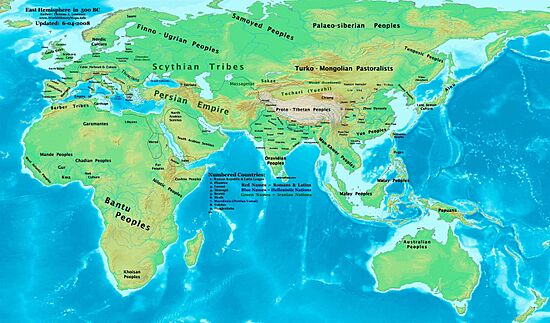List of political entities in the 5th century BC facts for kids
Imagine a "state" as a big, organized community of people living together. These communities have a leader, rules, and different groups of people doing different jobs. The creation of these states was a huge step in human history!
Archaeologists, who study ancient times, talk about two main types of states:
- Primary states are like the very first ones. They grew all by themselves, without being influenced by other states that already existed.
- Secondary states came later. They formed because they were near primary states and learned from them through trade, wars, or sharing ideas.
The earliest primary states appeared in places like Mesopotamia (around 3700 BC), Egypt (around 3300 BC), and the Indus Valley (around 2500 BC). Later, secondary states like the Hittites in Anatolia or the Minoan and Mycenaean states in the Aegean region started to form.
Today, when we talk about a "sovereign state," we mean a country that governs itself and isn't controlled by another country. This idea became common around the 1500s. Before that, leaders were often kings or emperors who ruled over their lands, sometimes with the help of powerful nobles.
This article lists some of the important states that existed between 500 BC and 401 BC.
Ancient States and Empires (500-401 BC)
Many different states and empires existed during this time. Some were very large, like the Achaemenid Empire, while others were smaller kingdoms or city-states. They often traded with each other, sometimes fought, and shared ideas.
Here is a list of some of these important states:
| State or Empire | Years it existed (or part of it) |
|---|---|
| Achaemenid Empire | 550 - 330 BC |
| Adena culture | 1000 - 200 BC |
| Ammon | c. 10th century - 332 BC |
| Anga | 1380 - 550 BC |
| Athens | 510 - 322 BC |
| Avanti | 900 - 322 BC |
| Bithynia | 297 - 74 BC |
| Cappadocia | 320 BC - 17 AD |
| Carthaginian Empire | 650 - 146 BC |
| Chavín culture | 900 - 200 BC |
| Chedi | 600 - 300 BC |
| Chen | 855 - 479 BC |
| Chera Kingdom | 5th century BC - 1102 AD |
| Chola | 2645 BC - 1279 AD |
| Chorrera | 1800 - 300 BC |
| Chu | 1030 - 223 BC |
| Colchis | 1300 - 2nd century AD |
| Corinth | 700 - 338 BC |
| Cyrene | 631 - 525 BC |
| Dʿmt | c. 980 - c. 400 BC |
| Dardanian Kingdom | c.448 BC - 28 BC |
| Edom | 1200 - 125 BC |
| Gandhara | 800 BC - 500 AD |
| Gojoseon | 2333 - 108 BC |
| Han | 403 - 230 BC |
| Kalinga | 1376 - 285 BC |
| Kamboja | 1450 - 195 BC |
| Kasi | 600 - 345 BC |
| Kikata | 2000 - 1700 BC |
| Kosala | 1000 - 266 BC |
| Kuru | 1376 - 285 BC |
| Kush | 1070 BC - 350 AD |
| Lu | 856 - 256 BC |
| Lycaonia | 8th century - 200 BC |
| Macedonia | 8th century - 146 BC |
| Mahajanapadas | 600 - 345 BC |
| Malla Republics | c. 7th century BCE - c. 4th century BCE |
| Mannai | 1110 - 616 BC |
| Maya civilization | 2000 BC - 900 AD |
| Minaea | 580 - 85 BC |
| Moab | 1300 - 400 BC |
| Mysia | 1320 - 301 BC |
| Nanda Empire | 424 - 321 BC |
| Olmec | 1400 - 400 BC |
| Panchala | 700 - 323 BC |
| Pandya | 1350 - 460 BC |
| Paphlagonia | 1480 - 183 BC |
| Paracas culture | 600 - 175 BC |
| Pisidia | 8000 BC - 11th century AD |
| Qi | 1046 - 241 BC |
| Qin | 845 - 221 BC |
| Roman Republic | 509 - 27 BC |
| Saba | 12th/8th century BC - 275 AD |
| Scythia | 8th century BC - 2nd century AD |
| Sparta | 11th century - 195 BC |
| Surasena | 1000 - 323 BC |
| Ta Netjeru/Land of Punt | 2400 - 1069 BC |
| Thebes | 3200 - 30 BC |
| Vajjika League | c. 7th century BCE - c. 468 BC |
| Văn Lang | 2879 - 258 BC |
| Vatsa | 1100 - 323 BC |
| Wei | 403 - 225 BC |
| Yan | 865 - 222 BC |
| Zapotec civilization | 700 BC - 1521 AD |
| Zheng | 806 - 375 BC |
| Zhou | 1045 - 256 BC |
See also
- List of Bronze Age states
- List of Iron Age states
- List of Classical Age states
- List of states during Late Antiquity
- List of states during the Middle Ages
|
List of political entities in the 5th century BC
|
||
| Preceded by 6th century BC |
Sovereign states of the 5th century BC |
Succeeded by 4th century BC |


